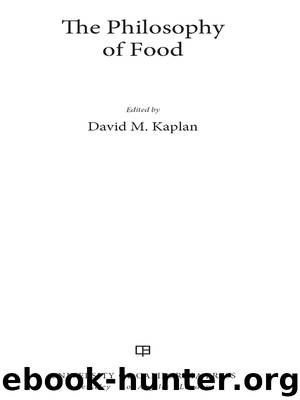The Philosophy of Food by Kaplan David M

Author:Kaplan, David M. [Kaplan, David M.]
Language: eng
Format: epub
Publisher: University of California Press
Published: 0101-01-01T00:00:00+00:00
CONCLUDING REFLECTIONS
Most ethical considerations of food safety have for the past several years focused on: (a) ethical concerns about the theory and practice of using scientific risk assessment in determining the safety of new products or ingredients; (b) concerns about the process by which the Food and Drug Administration approves new foods and especially new food additives; and (c) concerns about whether food labels—when required by the FDA—give consumers all the information they might want in order to make informed choices about the foods they purchase. Each of these concerns made their way into larger public debate in the case of GM foods or ingredients of foodstuffs.
Regarding the ethical concerns about using scientific risk assessment to determine food safety, it has been argued that scientific risk assessment (and management) is an imprecise tool. Test results are only as good as the tests; and while the tests have rapidly improved over the years (e.g., ascertaining parts per billion as opposed to parts per million), there remains a degree of uncertainty associated with any judgment that risks associated with a food are acceptable. Critics of GM foods claimed early on that the novelty of these foods and food ingredients, and the fact that there was no long-standing scientific or regulatory history associated with them, demanded a stronger testing requirement and generally a go-slow approach. It was suggested, for example, that a “precautionary principle” should be followed in assessing GM foods: these new foods should be evaluated using a “guilty till proven innocent” criterion. In other words, GM foods should not be allowed on the market until it can be shown, through years of rigorous testing, that there are absolutely no harmful effects associated with them.
The FDA responded by invoking what is called the doctrine of “substantial equivalence,” which means focusing on the specific product being proposed for approval, rather than the means by which the product came to be, and determining whether the new product is the same as the previously approved one for regulatory purposes. That a new soybean happens to have been genetically engineered means nothing if it is physically, biologically, and chemically the same as a conventionally bred soybean. GM foods that meet the doctrine of criterion equivalence need no additional testing. This debate still goes on, now supplemented with the concern that the whole FDA regulatory apparatus is flawed (see Thompson 2007; Burkhardt 2008).
Indeed, regarding food labels, the issue is that, until recently, the FDA did not require companies submitting new food products for approval to provide the data from their internal (or contracted-out) food safety evaluations. Instead, the FDA required only a report on the results of those tests. When the product (e.g., a GM food) had already been determined to be substantially equivalent and the new product and its ingredients fell within “generally recognized as safe” guidelines, no further analysis was needed (Shanklin and Sánchez 2005). Critics suggested that this revealed collusion between the food industry and the FDA and risked endangering the public; the industry can falsify data and results in order to get a product approved.
Download
This site does not store any files on its server. We only index and link to content provided by other sites. Please contact the content providers to delete copyright contents if any and email us, we'll remove relevant links or contents immediately.
Craft Beer for the Homebrewer by Michael Agnew(18200)
Marijuana Grower's Handbook by Ed Rosenthal(3648)
Barkskins by Annie Proulx(3338)
Project Animal Farm: An Accidental Journey into the Secret World of Farming and the Truth About Our Food by Sonia Faruqi(3194)
The Plant Messiah by Carlos Magdalena(2903)
Red Famine: Stalin's War on Ukraine by Anne Applebaum(2895)
0041152001443424520 .pdf by Unknown(2820)
Organic Mushroom Farming and Mycoremediation by Tradd Cotter(2664)
In the Woods by Tana French(2563)
Beer is proof God loves us by Charles W. Bamforth(2420)
7-14 Days by Noah Waters(2389)
Borders by unknow(2283)
Reservoir 13 by Jon McGregor(2267)
Meathooked by Marta Zaraska(2241)
The Art of Making Gelato by Morgan Morano(2234)
Between Two Fires by Christopher Buehlman(2226)
Birds, Beasts and Relatives by Gerald Durrell(2198)
The 7 Habits of Highly Effective People: Powerful Lessons in Personal Change (25th Anniversary Edition) by Covey Stephen R(2171)
The Lean Farm Guide to Growing Vegetables: More In-Depth Lean Techniques for Efficient Organic Production by Ben Hartman(2107)
